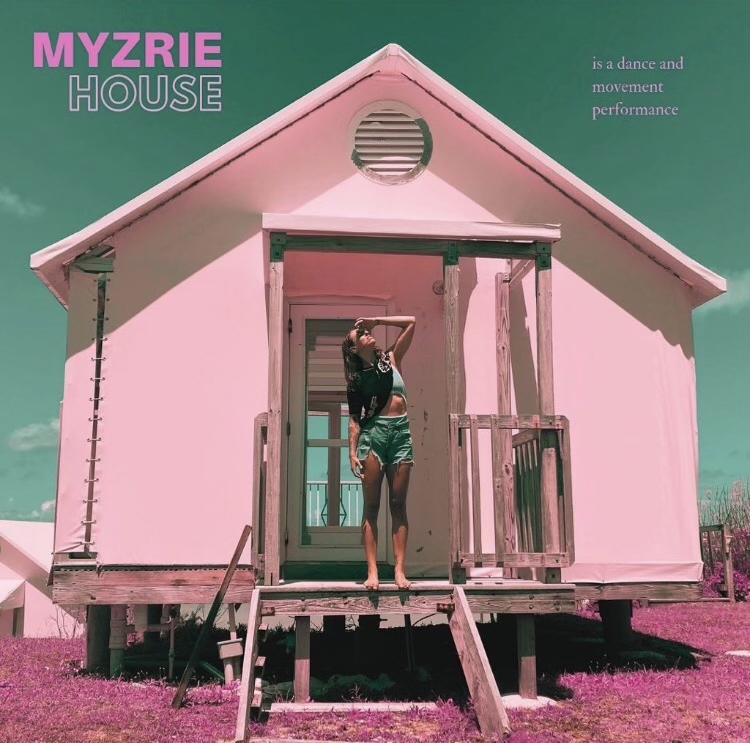Words by Madeline Shuron
Projected onto the wall is a scene H.G. Wells’ would have been proud of: black-and-white clips of military personnel are interspersed with low-budget, Twilight Zone-esque aliens and robots. The two groups are fighting each other with laser guns and death rays over a futuristic, chime-filled soundscore that will continue throughout the show. In the end (we shake our heads, shrug our shoulders, and say “of course”) the aliens prevail: all we’re left with is a long, looming shot of one lone human running throughout the empty streets.
Then the lights come up. He wakes up.
Ticks off another day on a tally-filled calendar that lives and breathes in the same expanse of cardboard boxes as he does.
And gets to work.
Myzrie House is the brainchild of Nicole Burgio and Mark Wong, two dancers working out of Philadelphia. It’s a true delight to see their movement worlds collide – each style works with the other to bring out its partners fluidity, grace, and technical skill. Throughout the hour-long show, Burgio and Wong move almost effortlessly through effort-heavy partnered and solo phrases that all strive to answer the question: who are you to me? What are we together?
Wong’s role as the sole survivor, trapped inside this cell, is quickly interrupted by the arrival of Burgio, who previously had only been a digital remainder of humanity as her image (crawling, confused, on the floor) was projected onto the same wall that had previously been showing the sci-fi prelude. As Wong began his daily rituals and routine (making coffee, marking the days), our attention is split between watching him – at ease, practiced – and watching the video of Burgio – panicked and on edge. When she finally arrives in the space, she’s accompanied by a lone aerial hoop. She climbs on, wrapping herself in glittering, holographic-toned black silk. Wong, upon noticing her, begins a careful unwrapping of what could be construed as a corpse: Burgio is limp and her arms fall off with the weight of her body being thrown around gingerly by Wong. When she finally comes to, it’s clear that there is a divide of knowledge between the two. Wong begins to take on the role of teacher, the possessor of knowledge: do this, eat this, drink this, and, above all else, don’t touch the surrounding red wires on the floor. Encasing the stage area separating the audience from performers, red LED lights are indicative of something along the lines of an electric fence: it causes a large, painful full-body shock to the life forms inside when approached by either people or items. Quickly, though, the two form a strong bond, finding comfort and solace in the other. To me, the relationship, with its giddy energy and tomfoolery, almost seemed like two children playing at being married. They show off to each other, they dance, they explore the upper realms of the cage by standing on stools or being hoisted up onto the others shoulders. But, every so often, an ominous countdown clicks down on the wall. At each interval, Burgio and Wong change – their sweats become glittery, silver bottoms, their bare feet are encased in red sneakers. As the countdown clicks on, their time in the cell is changing them. Slowly and slowly they become more futuristic, more spectacular.
Upon first glance, the parallels to a life inside COVID-caused quarantine are obvious, as found in most art produced or made during its hold on the world: two individuals stuck in one place together, with no way out, initially worried of what the other might do (or bring, or carry), passing the time by entertaining each other. But, to me, something much more sinister is lurking. The show functions as a voyeuristic operating theatre of sorts, placing Wong and Burgio as specimens or prisoners of war. That leaves us, the audience, to then be the conquerors of the scene we saw earlier: we are the aliens. We are delighting in their capture, aren’t we? Aren’t we entertained? We give them nice things to wear, we keep them safe. And, come the end when the two perform an all-out finale, showcasing every trick and talent in the books of aerial circus and hip-hop breaking, we give them their freedom, allowing the LED cage to flash green for a split second. But not enough time for them to leave. After all, wouldn’t that make our lives so much more boring?
Myzrie House balances the line between creepy and comforting, never quite giving catharsis but only ever raising the stakes. If the burning question at the center of the piece is about relationships, Burgio and Wong create characters who learn to rely and depend on each other not only for safety, but for comfort. Connectively, it speaks to a greater, global need to rely on one another – after all, the bonds we form are our primary humanistic trait. The choreography, co-created by Burgio and Wong, shines and leaves you gasping for more. Annie Wilson’s direction plays beautifully in the affective performances of Wong and Burgio, keeping us rooting for their safety and freedom all while delighting in the show they’re giving us. Hopefully for Philadelphian audiences, the three will keep working together to bring us more dazzling, mystifying worlds to dive into.
